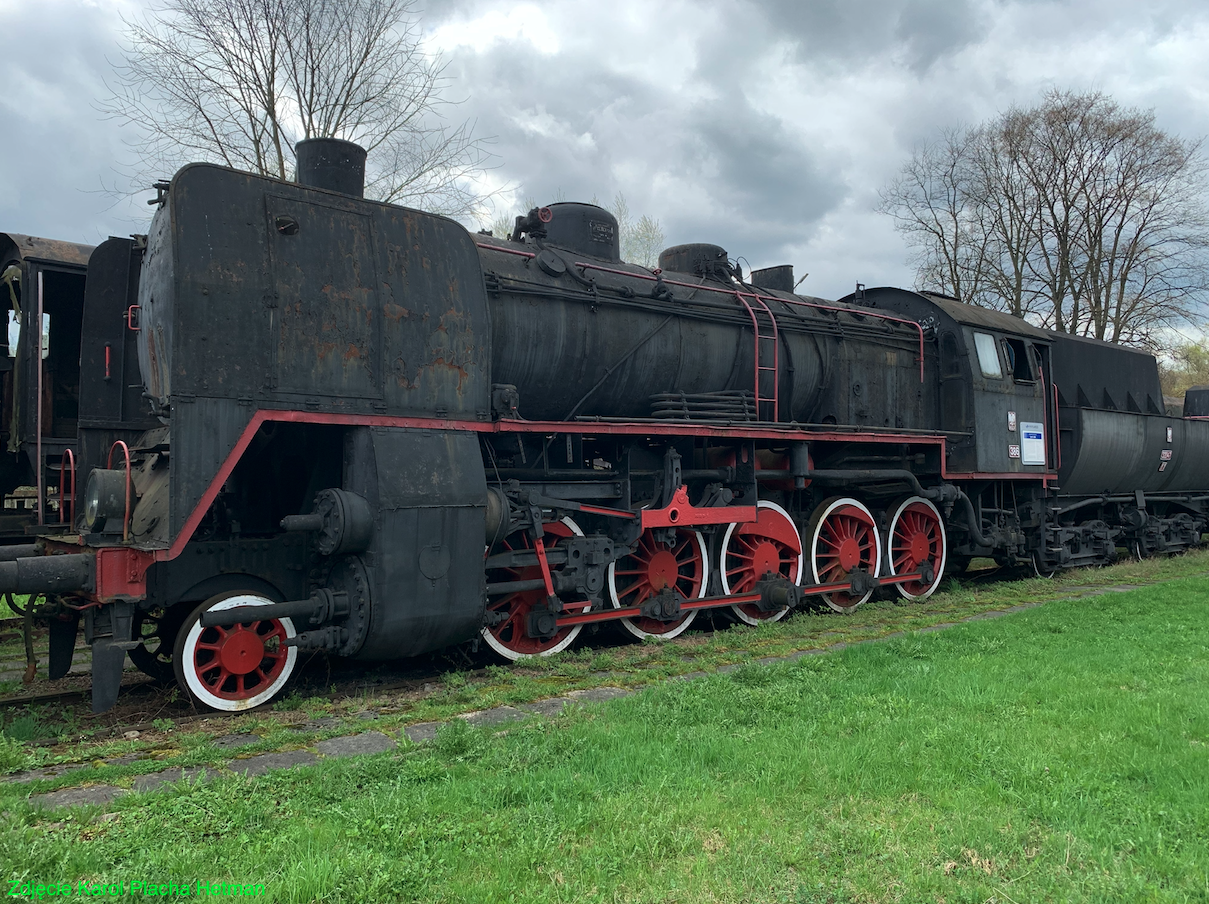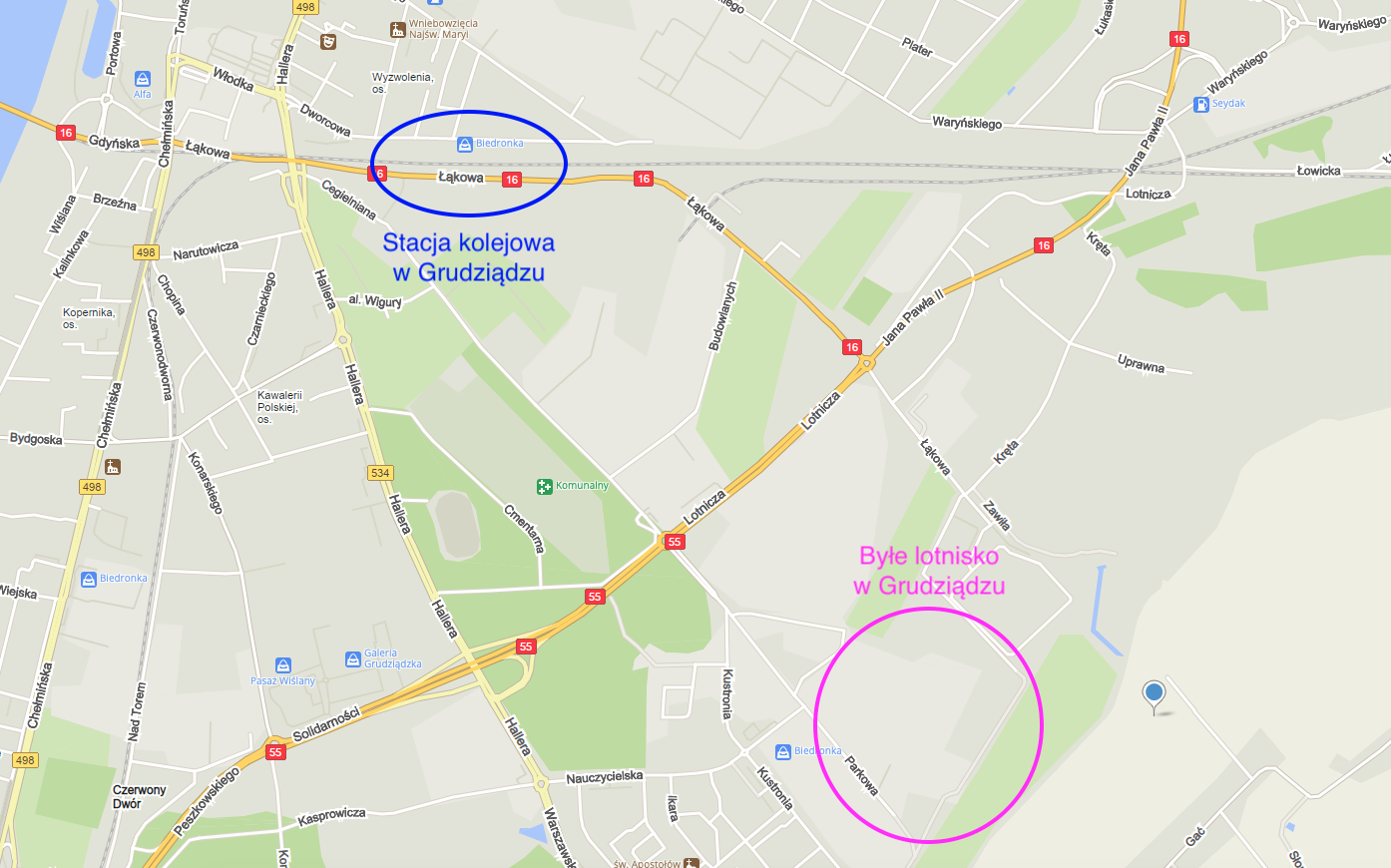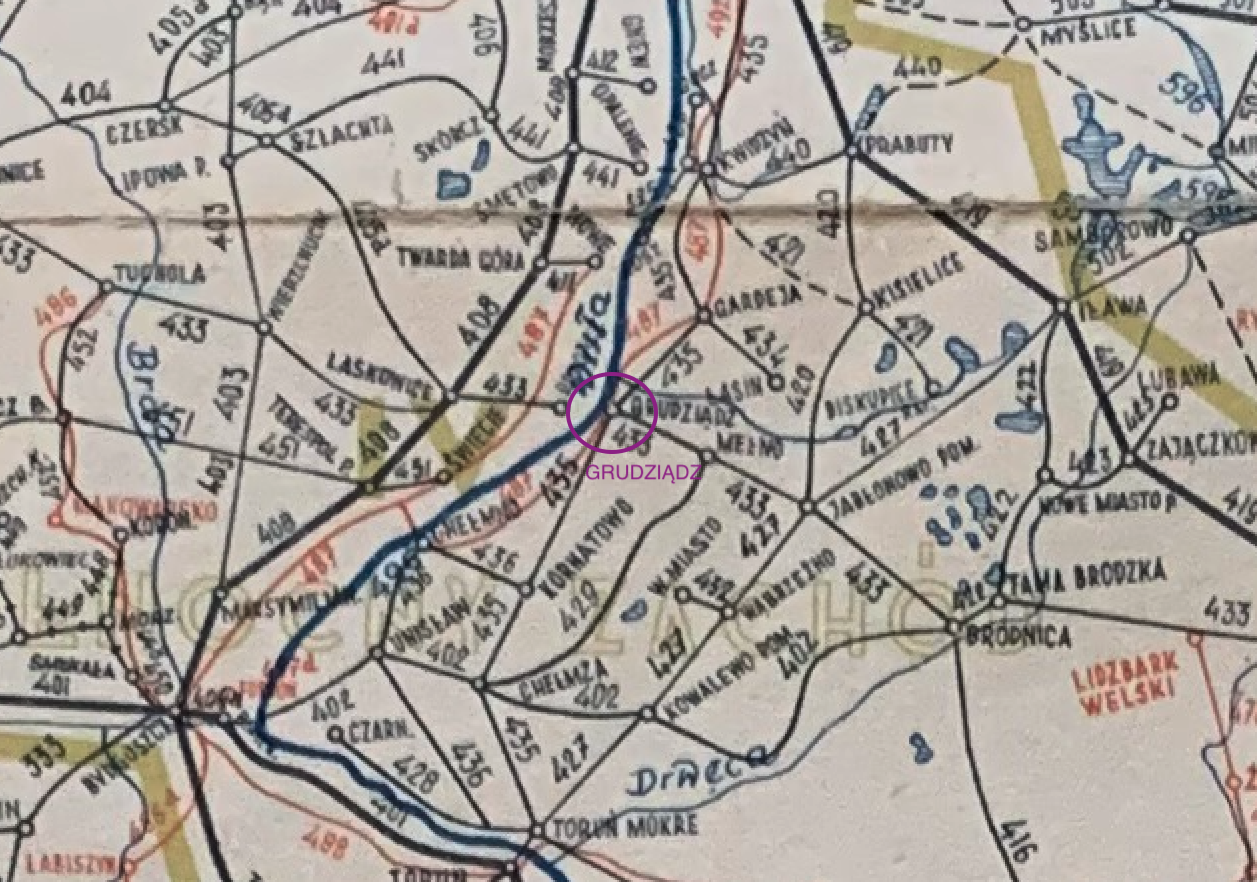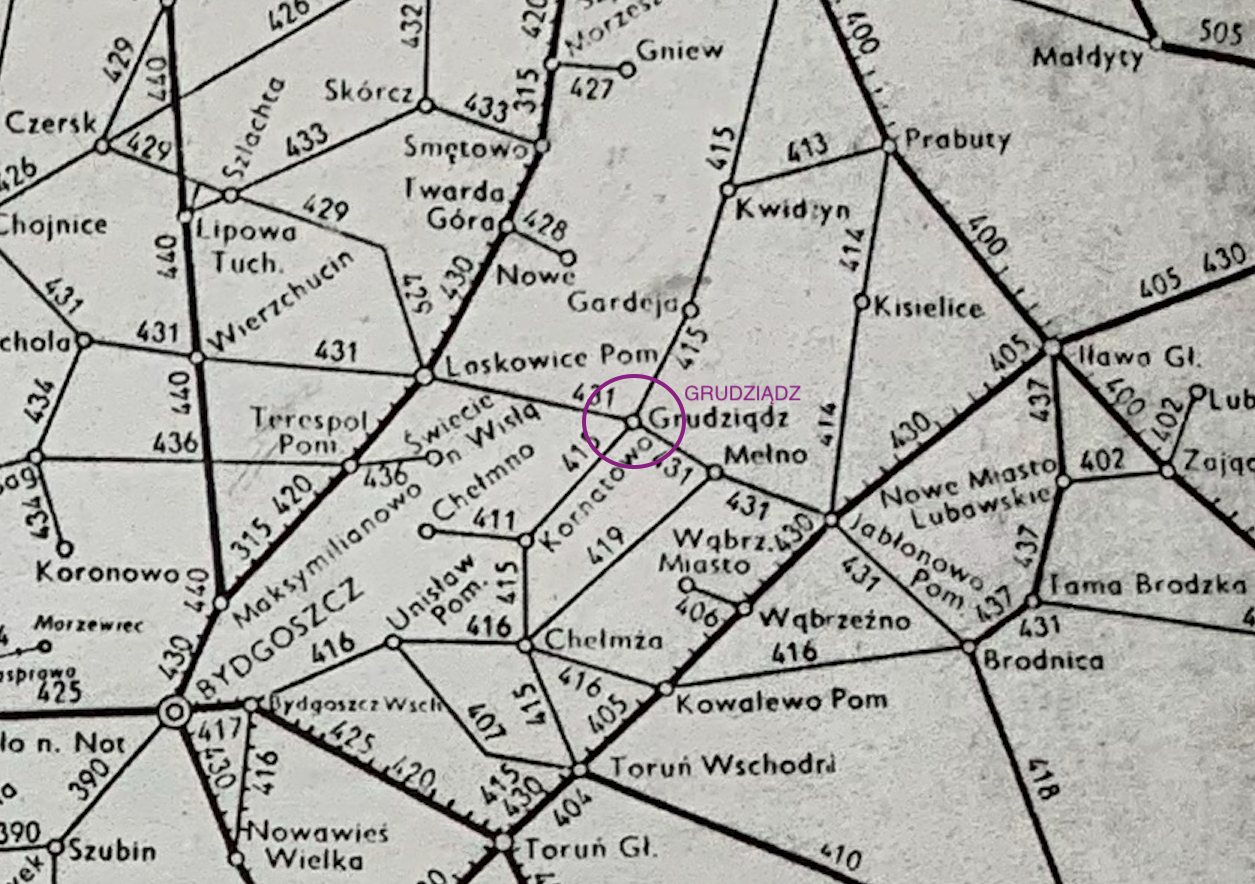Grudziądz 2021-04-13
Railway in Grudziądz.
Geographic coordinates: 53.466N 18.778E. Elevation 23 m.




In Grudziądz, the distance from the railway station to the former airport is only 1 km. This distance was covered by many Polish pilots and mechanics who, in September 1939, resisted the German army. In 1878, the first railway line was connected to Grudziądz, and at the same time a road and railway bridge over the Vistula was built. The airport was opened in 1911 and was used until 1980.
Bridge over the Vistula in Grudziądz.
The development of the city of Grudziądz depended on ferry crossings over the Vistula, and later on a permanent crossing, such as a bridge.
The first bridge over the Vistula was built near the town of Nowa Wieś below Grudziądz, on the order of King Władysław IV in 1635. The bridge's builder was Eliasz Arciszewski. It was a skate bridge, i.e. a wooden bridge whose structure is based on boats, which in the old Polish language were called skates. The first and last boats are anchored to the shore. The structure was not durable and in spring, when the ice floes flowed, the bridge had to be dismantled. In the history of Poland, the first skate bridge constructor was Master Jarosław, who built this type of bridge on the Vistula River near Czerwińsk during the war with the Teutonic Order in 1410. In Grudziądz, another skate bridge was built in 1655, on the orders of the Swedish king Charles Gustaf, during the Swedish Deluge. Further bridges were built in the period 1758-1762, when Muscovite troops crossed the Vistula. Presumably around 1800, a wooden bridge supported by piles was built.
However, the development of railways required permanent bridges, stone or steel. Therefore, in the years 1876-1879 (during the Prussian partition), a road and railway bridge was built. The bridge is 1,098.4 m long. To date, this bridge is the longest road and rail bridge in Poland, and at the time of its construction it was the longest in the German Empire.
Due to the strategic importance of the bridge, the Prussian authorities ordered a stone bunker and an iron gate to be built on the left bank, which closed the entrance to the bridge and the city. The bridge was built by two construction companies. The first one built powerful supports. The second one was the Union mining industry joint-stock company in Dortmund, which built eleven spans, each 100 m long. The steel spans were of the truss type, connected by hot riveting. In 1909, the bridge underwent a general renovation.
After the Great World War, Grudziądz was incorporated into the reborn Poland and the city was mostly inhabited by Poles. When the Germans attacked Poland on September 2, 1939, Polish sappers blew up the bridge, throwing three spans into the water. This blowing up hampered the attack of the Germanic army on Poland. During the occupation, from 1940 to 1942, the bridge was rebuilt. When the Moscow front was approaching, the Wehrmacht mined the bridge. It was probably blown up accidentally, because at that time there were hundreds of Germanic refugees on the bridge, with carts, strollers, bicycles and all their belongings. Many people died and others were injured. It was probably on February 21, 1945.
After the war, Poland tried to rebuild the bridge. However, it turned out to be very difficult, because each of them was so badly damaged that it was only suitable for scrap. The reconstruction of the bridge was commissioned to the outstanding Polish engineer Franciszek Szelągowski, who had completed several bridge reconstruction projects on the Vistula River. The reconstruction of the bridge in Grudziądz lasted between 1947 and 1951, according to the design of Franciszek Szelągowski. The bridge received a different truss system, but was supported on the same pillars.
Since 1981, the bridge has been named after the athlete and Olympian Bronisław Malinowski, who died on September 27, 1981 in a road accident on this bridge. Bronisław Malinowski's greatest successes were in the 3,000-meter steeplechase. He won Olympic medals at this distance twice: in 1976, in Montreal, a silver medal, and in 1980, in Moscow.
In 1999, the bridge underwent a general renovation. In 2020, decisions were made to renovate the bridge again.
The bridge is located on the lower Vistula River near the center of Grudziądz. Nearby, up the Vistula River, 7 km away, there is a new bridge along the A1 motorway (E75), which was put into operation in 2011. This bridge is made of reinforced concrete and is 1,954 m long. Down the Vistula, 35 km away, there is a road bridge along national road No. 90, near Kwidzyn. Another railway bridge over the Vistula, downstream is in Tczew, and upstream of the Vistula is the Fordoński road and railway bridge named after Rudolf Modrzejewski near Bydgoszcz, 1,005 m long.
The bridge in Grudziądz runs through the National Road No. 16 and the railway line No. 208 Laskowice Pomorskie - Grudziądz.
Railway route No. 208, on the Jabłonowo Pomorskie - Grudziądz section, 34 km long, was launched in November 1878. In 1879, the Grudziądz - Laskowice Pomorskie section was opened, across the bridge over the Vistula, 25 km long. In 2014, the Grudziądz - Laskowice Pomorskie section was renovated. Trail No. 208 is mostly unelectrified and single-track.
Railway station in Grudziądz.
The railway station in Grudziądz was opened in November 1878, simultaneously with the Jabłonowo Pomorskie - Grudziądz railway route. Currently, two railway routes intersect at the station: No. 207 Toruń Wschodni - Malbork and No. 208 Działdowo - Chojnice. In 2018, the station served approximately 1,500 passengers per day.
In 1885, a brick station with a post office and warehouses was built. The station building was built on the northern side of the railway tracks. There was a paved square in front of the station building, and horse-drawn trams ran along Dworcowa Street since 1896. The first tram line ran from the railway station along Dworcowa Street and today's Marszała Józefa Piłsudskiego Street to the intersection with Karabinierów Street. In addition to the station building, several railway buildings were built: warehouses, signal rooms, workshops. Most of them exist to this day.
In the period 1903 - 1904, a new, larger station building in the neo-Gothic style was built next to the first railway station. This building is on most postcards and photos from Grudziądz. The building had a large hall with ticket offices. There was a waiting room and a restaurant. At the top there were the service apartments of the railway workers and the restaurant owner. The first platform had a covered roof. The station design was developed in Berlin, at the Ministry of Public Works.
The station in Grudziądz continued to expand. In the eastern part of the station, on the northern side of the tracks, in 1911 - 1912, a locomotive shed was built. Currently (2021) the locomotive shed (locomotive shed) is closed. The locomotive turntable was completely removed. There is a water tower next to it, no longer in use.
The main station building was completely destroyed during the fighting for Grudziądz in 1945. In its place, between 1960 and 1963, a new station was built, with a large glass hall and ticket offices. The monotony of the interior is broken by a mezzanine located along the entire length of the building. The main entrance to the building is covered with a large shelter that protects passengers from bad weather conditions. The station is designed by Mr. Zbigniew Czekanowski, from the Transport Construction Design Office in Gdańsk, and by Mr. Konrad Kubiński, an engineer, and Mr. Bernard Cofta, an architect, in the field of interior design. The facility was officially opened in 1965 to celebrate the 900th anniversary of Grudziądz. In 2020, the railway station in Grudziądz, which was threatened with demolition, was entered into the register of monuments. Without a doubt, in the 1960s, the station was modern and functional. The design of the station in Grudziądz has gained recognition among architectural historians and is cited as an example of modern station architecture of the 20th century. Currently (2021), one of its users is the "Biedronka" retail chain store. By 2023, the station building is to be renovated.
Grudziądz railway station has three platforms. Platform 1 was renovated in 2015 and is covered. It is 227 m long. Platform 2 is roofed and 207 m long. Platform 3 is narrower and lower and is more of a technical platform. It is 250 m long. There is no roof. At the station, at the level of the tracks, there is also a technical road through the tracks. There is a tunnel for passengers under the platforms, which starts in the station hall and passes under all the platforms, and ends behind Droga Łąkowa Street (national road No. 16).
Railway traffic in Grudziądz.
Until 1990, the Grudziądz station was one of the most important railway junctions in this part of Poland. It had many connections with passenger and express trains. Electrification of railway routes was planned, but it did not take place.
In the following years there was a regression. Further connections were canceled as they were considered uneconomic. In 2009, Grudziądz lost its last long-distance train connection. In recent years, the Grudziądz station was bustling with life, it had many regional and fast connections, which were slowly withdrawn for economic reasons, which led to the fact that since 2009, Grudziądz has not had any long-distance trains.
Until 2006, trains ran through the station, for example: the "Liwa" accelerated train on the route: Toruń Główny - Gdynia Główna, via Grudziądz, Kwidzyn, Malbork. Expedited train "Bursztyn" on the route: Grudziądz - Słupsk, via Kwidzyn, Malbork, Gdynia Główna.
Until 2007, for example: accelerated train "Powiśle" on the route: Brodnica - Bydgoszcz Główna, through Jabłonowo Pomorskie, Grudziądz, Laskowice Pomorskie. Fast train "Bory Tucholskie" on the route: Warszawa Zachodnia - Kołobrzeg, through Działdowo, Lidzbark, Brodnica, Jabłonowo Pomorskie, Grudziądz, Laskowice Pomorskie, Tuchola, Chojnice, Szczecinek.
Until 2009, for example: fast train "Warmia" on the route: Kraków Płaszów - Grudziądz, via Działdowo, Brodnica, Jabłonowo Pomorskie.
Until 2013, for example: direct passenger trains: Malbork - Toruń Główny.
Since 2015, the Grudziądz station has been served by the carrier Arriva, which operates local connections. There are trains to: Brodnica (9 pairs), Toruń (13 pairs), Laskowice Pomorskie (8 pairs), Malbork (4 pairs), and Bydgoszcz (6 pairs). The Arriva carrier mainly uses two-car PESA 218Mc type SA133 units.
A big problem is the lack of electrified roads. Therefore, only trains with diesel locomotives or DMUs (Diesel Traction Sets) can run here. In 2020, InterCity trains returned to Grudziądz on a pilot basis, operated by modern SM4210 locomotives, which pull 2-4 passenger cars without compartments or compartments.
Written by Karol Placha Hetman
